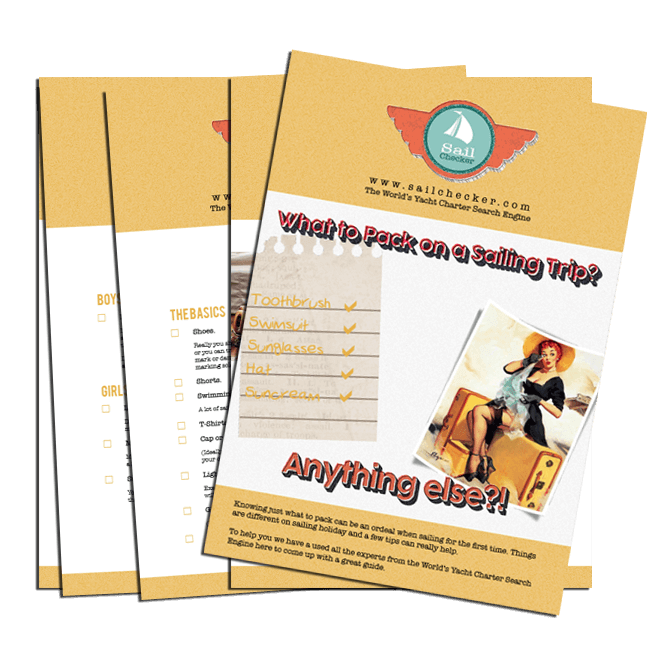What to Pack for a Sailing Holiday
The Ultimate Sailing Packing Guide
Packing for a Sailing Vacation
Avoiding that… Sinking Feeling
What to Pack for a Sailing Holiday. Few things kill day‑one buzz faster than realising your phone lead is still at home, you’ve no flip‑flops for the dinghy run, or your only beach towel just dived overboard because you skipped the pegs. This no‑fluff sailing holiday packing list sets you up for success: the must‑have kit, the space‑saving hacks, and the clever extras that keep cabins tidy and crews happy. Whether it’s a week‑long yacht charter or a quick island hop, scroll on, download the checklist, and pack with confidence.

Yacht booked, flights paid, transfer sorted—then it hits you: what on earth do I pack for a sailing holiday?
What to pack for a sailing charter: yes, you’ll need the usual suspects—quick‑dry clothes, swimwear, a light jacket for night passages, reef‑safe sunblock, dark sunglasses, and a hat that won’t launch itself overboard. But there’s more to it than that. To save you the guesswork, we’ve broken every item down in this guide and wrapped it all into a printable checklist you can download in seconds.
DOWNLOAD YOUR FREE CHECKLIST AND GUIDE
60‑Second Sailing Holiday Packing List
Everything you need – nothing you don’t – for a smooth, stylish charter
- 3 × quick‑dry tees / rash vests (one per sailing day)
- Board shorts / light leggings + 1 pair long trousers for evenings
- 3 × swimwear sets – rotate & rinse
- Light fleece or hoodie (nights can surprise you)
- Packable wind‑/spray‑top for squalls
- Soft‑soled deck shoes and flip‑flops/sliders
- Evening outfit (shore dinners & “theme night” fun)
- Sun hat or cap + buff/scarf for neck protection
- 5 × undergarments & quick‑dry socks
- Reef‑safe SPF 50 sunscreen + after‑sun aloe
- Biodegradable body wash & shampoo (travel size)
- Toothbrush / paste / floss
- Deodorant • razor / shaving kit
- Sea‑safe dry shampoo (great on no‑wash days)
- Insect repellent (tropics & sunset mozzies)
- Mini first‑aid stash: plasters, pain relief, antihistamine
- Motion‑sickness tabs or ginger chews
- Microfibre towel + wash‑cloth / flannel
- 12 V dual‑USB lighter adapter + multi‑port wall plug
- 10 000 mAh (or bigger) power bank
- Water‑/splash‑proof phone case & pouch
- Head‑torch (hands‑free night moorings)
- Camera / GoPro + spare SD & batteries
- Bluetooth mini‑speaker (and 3.5 mm aux for older stereos)
- Offline nav app pre‑downloaded (Navionics, Savvy Salt etc.)
- All charging leads clearly labelled – carry a spare USB‑C / lightning
- Passport (6 + mo validity) + digital/photo copy
- Sailing licence / ICC | VHF cert if you’re skipper
- Travel & medical insurance docs
- Credit card + small local cash
- Prescription meds (trip + 2 days)
- Vaccination / health certs if required
- Emergency contacts sheet offline & in the cloud
- Soft‑sided duffel (no wheels) – boat‑stowage friendly
- Reusable water bottle (stay hydrated, cut plastic)
What, Where and When
What you pack depends on several key factors: the climate at your sailing location and time of year, your role on the crew, how far you intend to sail, whether you plan to eat on board (and how often), if you’ll be doing any night passages, and more.
That’s why no single packing list suits every trip. Instead, we’ve created a practical guide packed with tips—and a downloadable checklist you can use to tailor your own perfect list.
Clothing
Clothing tends to be the biggest source of indecision. If you haven’t sailed before, your go-to holiday wardrobe might consist of stylish outfits for dining and strolling. While it’s good to have something for every occasion, sailing calls for lightweight, comfortable clothes that can handle a bit of saltwater.
Your clothing choices will also depend on who you’re sailing with and your personal modesty level—boarding a dinghy in a short skirt, for instance, can present practical (and social) challenges. Versatility and ease of movement are key.
1. What to Pack on a Sailing Holiiday
We aim to take a comprehesive look at what to pack, yet do consider your own personal preferences too.
The Basic Principle of Knowing What to Pack for a Sailing Holiday
Even on larger boats, storage space is tight. Get it wrong, and you’ll either forget the essentials—or worse, end up sleeping with your gear as it spills across your cabin. With a bit of forethought, though, you can strike the perfect balance. Here’s my advice:
Pack. Remove half. Remove half again. You’ll be about right.
First Things to Consider When Thinking About What to Pack
Before diving into a checklist, take a moment to think about the bigger picture. The right packing choices depend on:
- Climate. Will it be warm—and stay warm at night? As a rule of thumb, you’ll need one more layer at sea than ashore. If it’s bikini weather on land, a wrap or light tee will make sailing more comfortable.
- Type of Boat. That extra layer becomes essential if you’re racing along at 25 knots on the flybridge of a motor yacht. Sure, you’ll see people in bikinis and bare chests defying the chill—I might just feel the cold more than most!
- You. We’re all different. Your personal comfort threshold matters, so pack to suit your needs. Don’t be afraid to slip in a hoodie just in case. And consider where you’ll be eating—some people won’t mind squeezing into tight waterfront tavernas, while others will want something dressier for upscale dinners.
- Type of Sailing. A week of long hops across the windy Greek Cyclades needs different kit than the easy line-of-sight sailing in the British Virgin Islands. Think about your daily rhythm on board.
- Destination. Some places are all about laid-back beach bars and casual tavernas, where anything goes. But if you plan to step into high-end resorts in the Bahamas, you’ll want to pack accordingly.
2. Washing and Shaving
Whilst they might be the first thing in your lugage, some things to think about.
We are not all the same. The author of this blog likes nothing more than waiting for everyone to head for their cabins before showering off the back of the boat. I take my saltwater soap and have, what is for me, a luxurious wash and brush up. I am drinking my first cocktail long before the first person heads back up.
I don’t have hair that needs straightening or drying, bear in mind, that unless your yacht has a powerful generator on board, none of these things will work. Of course, sailing is all about beach hair and looing and feeling fabulous with it, gain, take a second to think through your routine and what you need.
- Shower Gel. Those, ahem, halve used ones from hotels are great.
- Shampoo. (same tip)
- Flannel. Even if you’re not a flannel person, they are extremely useful on boats where they can be easily washed and dried and be used for all sorts of things.
- Toothpaste (and brush). Most chemists stock that little testers, my tip is to ask your dentist who gets sent loads of them.
- Hairbrush/Comb.
- Universal Basin Plug. Another Top Tip. You find yourself in some swanky marina, you’re using the beautiful individualised cabins, only to find someone has had a way with the plug.
- Deodorant.
- Contact lens cleaner.
- Washing powder. Just a little. Your favourite smaller lighter thangs can be washed and used again to save you space.
- Hair bobbles and Grips. If you have long hair, make you have a few spares of your favourite devices.
Think of anything I missed? Please leave a comment at the bottom of the blog and future sailors looking for what to pack on a sailing holiday will be eternally grateful, as will I.
3. Medical, Protective and Sleep
This might be one of the hardest things to solve if you don't get it right.
🩺 Medical Essentials
Even if your boat includes a basic first aid kit, it’s wise to pack items you know work best for you.
- Prescription Medicines: Bring enough for the entire trip, plus a little extra in case of delays. It’s also smart to check import rules for your sailing destination before travel.
- Basic First Aid: Include pain relief, anti-inflammatories, antihistamines, and seasickness tablets. See the REI First Aid Kit Checklist for a reliable guide.
- Personal First Aid Kit: Even if your boat has one, a compact kit with plasters and bandages is a great backup. This Boat Medic Kit is well-reviewed and compact.
🧢 Protective Gear
Sun, wind, and sea can all take their toll — a little preparation goes a long way.
- Sunglasses: Invest in polarized lenses that block UV rays. Check out Yachting Monthly’s picks for sailing sunglasses.
- Hat: Bring a wide-brimmed or peaked hat that won’t blow off easily. Bucket hats with neck straps are a sailor favourite.
- Anti-Seasickness Remedies: Read our guide to sea sickness remedies for natural and medicinal options.
- Sunscreen: Bring reef-safe, waterproof sunblock — the sea reflects UV, so double up. We recommend this guide to reef-safe options.
🛌 Sleep Comfortably
A good night’s sleep makes or breaks your sailing holiday.
- Bedding: Most European charters provide it, but check in advance — UK boats often don’t. If in doubt, bring a sheet sleeping bag.
- Sleeping Bag: Especially if you’re in cooler waters or on early/late season trips. Don’t underestimate how cold it can get at night.
- Pillow or Pillowcase: A pillowcase stuffed with clothing can double as a travel pillow and save space.
- Pyjamas: Lightweight and breathable are best. A fleece layer can help if the temperature drops.
- Hot Water Bottle: Not needed in the Med or Caribbean — but a comfort in UK waters or early spring charters.
Food for Thought
- Hammock: Trusted by sailors for centuries. Great for napping or relaxing. This Amazon hammock is lightweight and easy to store.
- Wind Scoop: A passive cooling device that funnels wind below deck — a must-have at anchor. Consider this well-rated option.
Still not seeing the product images? You might need to temporarily disable your ad blocker.
4. What to Wear When Underway.
All the Gear... No idea!
📚 Once You’re Underway
Life aboard changes once you’re underway — and your experience will vary depending on your role aboard.
If you have a permanent skipper, they’ll handle most of the responsibilities, giving you plenty of time to relax, read a book, or simply watch the sea roll by. If you are the skipper, your workload and preparation will depend on how much support you have and the kind of sailing you’re doing.
For example, a 20-minute line-of-sight hop in the British Virgin Islands is quite different from a longer, windier passage between islands in the Cyclades — especially if you’re doing some night sailing or navigating unfamiliar harbours.
🧳 Everyday Clothing & Comfort
Regardless of your sailing style, here are some basics you’ll be glad you packed:
- Socks: Especially useful if you plan to wear deck shoes or if nights get cool.
- Shorts: Lightweight and quick-drying is ideal.
- Leggings or Light Trousers: Great for evenings or protection from sun and bugs.
- T-Shirts/Tops: Breathable and suitable for layering.
- Swimwear: One is never enough. Quick-drying fabrics are a plus.
- Synthetic Tees: Wicking fabrics are ideal for active days or longer passages.
- A Good Book (or Two): Kindle or paperback — we love this seafaring booklist on Goodreads for inspiration.
5. Foul Weather Gear
Think Through Every Scenario
🧭 What You Pack Depends on You
There are so many variables here. As mentioned earlier, what to pack for a sailing holiday depends on your destination, time of year, and the type of sailing you’re doing.
But it also depends on you. Are you the skipper or the mate? Are you the one who’d helm for hours in the rain on the final day just to return the yacht on time?
Some sailors never leave home without their trusted oilskins, regardless of the forecast. And that’s not a bad shout. Personally, I always roll up my old breathable dinghy smock and stash it at the bottom of my bag. Over the years, it’s saved me more than once — without the bulk of my full offshore set, which is usually overkill in holiday destinations.
If you’re unsure what conditions to expect, it’s worth checking destination-specific advice. For example, the Noonsite Cruising Hub is a great resource for local weather quirks and regional sailing norms.
6. Shore Gear
Lot's of Light Clothes are Perfect when Packing for a Sailing Holiday
🧺 Cotton vs. Quick-Dry: The Packing Dilemma
One decision I still wrestle with: the comfort of cotton versus the practicality of synthetics. Cotton feels great in warm, dry conditions—but once it’s wet, it clings, takes forever to dry, and adds to your laundry pile.
Modern man-made fabrics, on the other hand, have come a long way. They’re designed to dry fast, keep you warm even when damp, and rinse out easily in a quick wash—often ready to wear again the same day. For sailing, that can mean packing lighter and staying more comfortable overall.
If you’ve not tried them recently, it’s worth checking out brands that specialise in quick-dry travel wear, like Rab’s technical base layers—built for the elements but subtle enough for a casual night ashore.
7. Documents. Licences, Visas & Permits
Travel Needs Plenty of Documents - Don't Let a Small Slip a Big Effect
📄 Essential Documents to Pack
It may sound obvious, but forgetting key documents can derail your trip before it starts. As well as ticking off the list below, be sure to check all expiry dates and, if applicable, carry digital backups on a secure cloud or your phone.
- Passport – Check it has at least six months’ validity from your return date.
- Visas – Required for some destinations; VisaHQ can help you check requirements.
- Sailing Licences – Including ICC or RYA Day Skipper certificates if you’re skippering.
- Logbook – Useful for bareboat charters and building experience.
- Vaccination Records – Especially relevant post-COVID or for certain regions.
- Credit/Debit Cards – Let your bank know you’re travelling.
- Cash – Still king in some marinas, especially for fuel or small taverna bills.
8. Baggage
A Contriversial Subject with Non-Sailors
🧳 The Best Bag for a Sailing Holiday
Travellers have become accustomed to wheeling their luggage effortlessly through airports and train stations. Some sailing-specific bags even come with wheels these days. But seasoned sailors know: the best bag for a sailing holiday is a soft, flexible one—with no wheels.
Hard-shell suitcases or rigid bags that can’t compress into tight storage spaces become an inconvenience on board. I’ve seen many guests forced to sleep beside their large, solid cases, or sacrifice precious wardrobe space. A soft duffel or collapsible bag, like this one from Decathlon, can be folded away neatly once you’ve unpacked.
Remember, space is at a premium on yachts, and smart packing starts with the right bag.
9. The Little Things
Get your thinking caps on!
🔌 Tech, Power & Essentials
So, you get halfway across the world only to realise you’ve forgotten the charging lead for your phone—or worse, didn’t pack a battery for your camera. These are the moments that separate a smooth sailing holiday from a frustrating one.
Exactly what you need to pack will vary. For instance, if your yacht has a generator and full-time 110V/220V power, then my usual tip about bringing a 12V inverter may not be necessary. But if you’re unsure, it’s best to prepare for a lower-power setup and adapt up.
- Pegs! Keep your towels, swimsuits, and light items from launching themselves into the sea the moment your back is turned.
- Camera. Smartphone cameras are brilliant these days, but if you want that satisfying depth of field and higher quality stills, consider a dedicated camera too.
- 12V Inverter. Converts 12V power into 110V/220V—great for charging laptops or cameras when mains power isn’t available. Won’t work with hairdryers, straighteners, or kettles.
- Audio Adapter. Especially on older boats, a 3.5mm aux jack or Bluetooth adapter can be the only way to play your music.
- 12V USB Adaptor. Bring one with multiple ports—ideal for charging phones, GPS devices, and GoPros all at once.
- Universal Travel Adapter. A multi-country travel adapter can be a lifesaver when dealing with different plug types between shore and yacht.
- Charging Leads. Bring spares. One for your phone, one for your Kindle, one for your camera. You’ll thank yourself.
- USB Charging Hub. If you do have mains power or an inverter, a hub with 4–6 USB ports makes life easier and keeps the galley clutter-free.
- Navigation App. Navionics is the industry standard and ideal for tracking your route, anchorage planning, or just geeking out mid-passage.
- GoPro (or similar). These waterproof, shock-resistant cameras are perfect for capturing your sailing memories—especially snorkelling or jumping off the stern.
- Extra Tea Towels. Honestly, there’s no such thing as too many. From drying dishes to mopping spills, they’ll always find a job.
- Compact Torch or Headlamp. Invaluable at night—especially if you’re returning to the boat by dinghy or there’s a power cut onboard.
- Power Banks. Bring one with enough juice for at least two full phone charges. If it’s solar or water-resistant, even better.
10. Sailing Shoes
A Confiedenct Mix of Appropriate Footware
Footwear
Footwear on a yacht is a much-debated topic. Some swear by going barefoot for better feel and agility on deck. Others prefer the protection of closed-toe shoes to avoid painful stubbed toes. One thing is clear—certain types of footwear, like stiletto heels, are universally banned due to the risk of damaging decks.
Here are a few practical and popular options to consider when packing for your sailing holiday:
- Deck Shoes. Designed specifically for sailing, proper deck shoes offer non-marking razor-cut soles for grip on wet surfaces. Don’t confuse these with clunkier ‘boat-style’ casual shoes—look for functionality over fashion. We recommend checking out Ladies’ Deck Shoes and Men’s 2-Eye Nubuck Deck Shoes.
- Sliders or Flip Flops. Ideal for short hops ashore or shower blocks at marinas. Choose waterproof and quick-dry versions with decent grip.
- Deck Boots. Usually overkill for warm-weather holidays, but breathable sailing boots are a favourite among serious sailors and can double as great wet-weather gear in colder destinations like Scotland or the Baltic.
If you’re unsure, take a look at our Complete Sailing Holiday Packing Guide to get the full picture of what you might need onboard.
What type of Bag Should I Use?
Stowage space is a premium on all but the largest boats and catamarans where things are a bit more spacious. The ideal bags to pack are soft and without any kind of frame. You can easily stow your belongings in your cabin, your bags can pack away safely somewhere deeper. Anything bigger of stiffer, then you will have to ‘live’ with it. This means moving it around at sleep time, and when trying to access equipment that might be stowed under your bunk.
If you don’t see anything you will have to disable your Ad Blocker.
A Thought About Safty
Lifejackets are provided by law on every charter boat in every jurisdiction. It’s a really good idea to try them out of day 1, the chances of you needing them are rare, but should the moment arise, it’s nice to have that confidence.
The life jackets are likely to the cheap, but very effective foam type. This makes them very difficult to wear as a precautionary measure. If you are a weak or non-swimmer, likely to sail far from the land or in windy conditions, you should consider your own PFD.
The horseshoe style ones are much easier to wear as a precaution. We recommend the Baltic Winner 150N Manual Lifejacket with Harness.
If you don’t see anything you will have to disable your Ad Blocker.
Leads & Electronics
If you start sailing, and suddenly realise that you have no way of charging your phone, life can get a bit tricky. One of top tips (you will find the rest on the checklist) is to ensure you have a 12V USB Charger, the type that goes into the cigarette lighter. Nearly all boats have these fittings, and if you get one with a couple of ports, it will ensure you can charge one or two devices. Most yachts have some kind of sound system. The best way to get your own tunes is to have a lead that runs from your iPod or smartphone to the radio; ask for a 3.5mm – 3.5mm jack lead.
If you don’t see anything you will have to disable your Ad Blocker.
How much gear to bring?
When I brief my crews it’s some pretty straight forward advice. Pack, remove half, remove half again, and you should be about right! Okay, that’s a bit tongue in cheek, but you are more likely to make too much, than not enough. For those serious about sailing, he’s a great bag that will never let you down.
Download Your Free Checklist
Our comprehensive 7-page checklist and guide of what to pack on a sailing holiday.:
[optinlocker]
Click here to view or download
[/optinlocker]
















